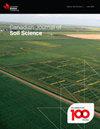利用耕作有机土层深度形成水土保持管理区
IF 1.5
4区 农林科学
Q4 SOIL SCIENCE
引用次数: 6
摘要
摘要蒙特利尔西南平原的有机耕作土壤是魁北克省生产力最高的土壤。有机土壤在经过最初的排水以进行耕作后,容易受到多种形式的退化和土壤流失的影响。在这项研究中,我们对来自五个泥炭地的114个地点的物理、化学和土壤特性进行了表征,以形成土壤保护管理区。我们试图使用最大泥炭厚度(MPT)作为土壤退化的代理。MPT可以定义为泥炭层的厚度,直到达到共生或矿物材料。后者是不希望的生长介质,在MPT计算中不考虑。一系列多变量方差分析表明,MPT与土壤退化中度相关(最优模型的皮莱迹=0.495)。定义了三个土壤退化组,由两个MPT阈值分隔:60和100 cm。当观察17个不同深度特性组合时,较浅的场地(MPT<60cm)表现出明显高于MPT>60cm的场地的土壤退化迹象。第二个阈值是出于实际目的提出的。然后,使用这些阈值将研究区域划分为空间上不同的管理区域。发现了重要的空间对比。这支持了一种理论,即精准农业技术需要针对农田来优化土壤保护干预措施。应进一步探讨MPT与土壤退化之间的关系,以考虑其他退化因素,并更好地识别退化土壤和面临风险的土壤。本文章由计算机程序翻译,如有差异,请以英文原文为准。
Using cultivated organic soil depth to form soil conservation management zones
Abstract Cultivated Organic soils in Montreal's southwest plain are the most productive soils in the province of Quebec. After their initial drainage to enable farming, Organic soils are susceptible to many forms of degradation and soil loss. In this study, we characterized the physical, chemical, and pedological properties of 114 sites from five peatlands to form soil conservation management zones. We attempted to use the maximum peat thickness (MPT) as a soil degradation proxy. The MPT can be defined as the thickness of the layer of peat until coprogenous or mineral materials are reached. The latter are undesired growing media and are not considered in MPT calculation. A series of multivariate analysis of variance indicated that MPT was moderately related to soil degradation (optimal model's Pillai's trace = 0.495). Three soil degradation groups were defined, separated by two MPT thresholds: 60 and 100 cm. When looking at 17 different depth-property combinations, shallower sites (MPT < 60 cm) showed signs of soil degradation significantly higher than sites with an MPT above 60 cm. The second threshold was proposed for practical purposes. Then, these thresholds were used to separate the study area into spatially distinct management zones. Important spatial contrasts were found. This supports the theory that precision agriculture techniques are needed to target fields to optimize soil conservation interventions. The relationship between the MPT and soil degradation should be further explored to account for other degradation factors, and to better identify degraded soils and soils at risk.
求助全文
通过发布文献求助,成功后即可免费获取论文全文。
去求助
来源期刊

Canadian Journal of Soil Science
农林科学-土壤科学
CiteScore
2.90
自引率
11.80%
发文量
73
审稿时长
6.0 months
期刊介绍:
The Canadian Journal of Soil Science is an international peer-reviewed journal published in cooperation with the Canadian Society of Soil Science. The journal publishes original research on the use, management, structure and development of soils and draws from the disciplines of soil science, agrometeorology, ecology, agricultural engineering, environmental science, hydrology, forestry, geology, geography and climatology. Research is published in a number of topic sections including: agrometeorology; ecology, biological processes and plant interactions; composition and chemical processes; physical processes and interfaces; genesis, landscape processes and relationships; contamination and environmental stewardship; and management for agricultural, forestry and urban uses.
 求助内容:
求助内容: 应助结果提醒方式:
应助结果提醒方式:


